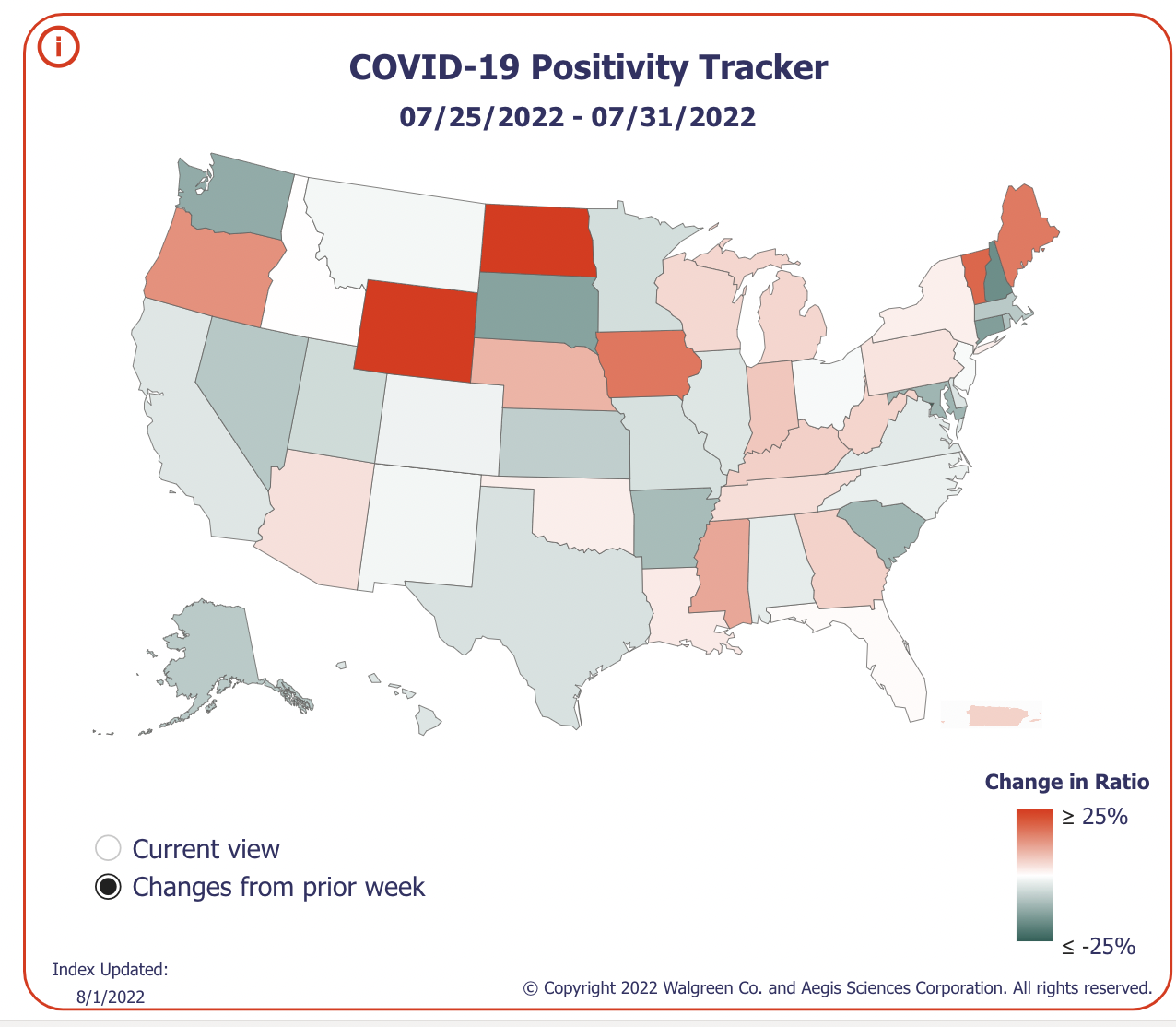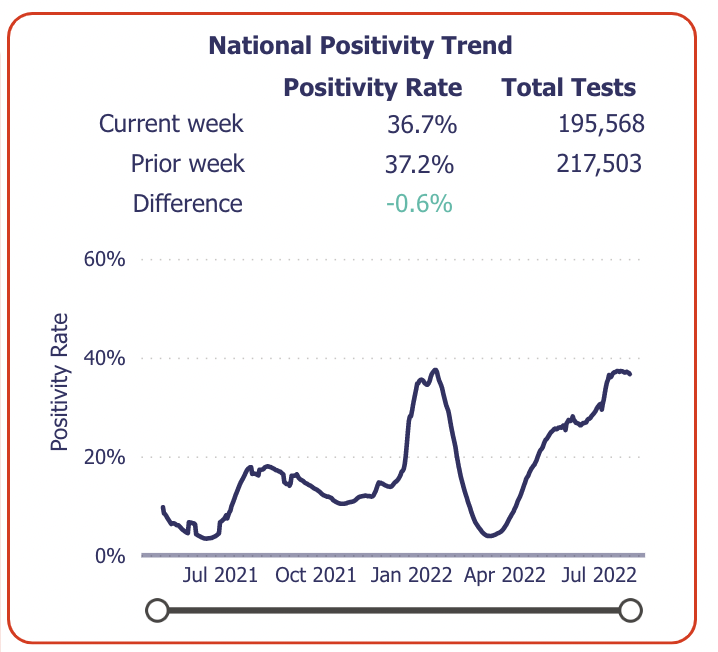 Covering COVID-19 is a daily Poynter briefing of story ideas about the coronavirus and other timely topics for journalists, written by senior faculty Al Tompkins. Sign up here to have it delivered to your inbox every weekday morning.
Covering COVID-19 is a daily Poynter briefing of story ideas about the coronavirus and other timely topics for journalists, written by senior faculty Al Tompkins. Sign up here to have it delivered to your inbox every weekday morning.
The Walgreens drug store chain posts the results of the COVID-19 tests it oversees, and the picture is grim. More than a third of the tests are positive and some states have seen a spike of 25% in the last week. Click on the map, which is linked to an interactive for each state.
Is monkeypox an STD?
The answer is yes and no. In all of the 60 or so years that monkeypox has infected people, it has not been spread by sexual contact. But that is one way that it is spreading now. The World Health Organization last week advised men to consider reducing their sexual partners “for the moment.” The WHO says 98% of the monkeypox cases detected since May have been among gay, bisexual and other men who have sex with men.
But the WHO’s warning also shows that monkeypox is not only transmitted through sexual contact, so to call it an STD might lead people to believe there is no danger if they are not having sex with an infected person. The WHO says among the ways the virus can be transmitted are:
- Monkeypox is transmitted to humans through close contact with an infected person or animal, or with material contaminated with the virus.
- Monkeypox virus is transmitted from one person to another by close contact with lesions, body fluids, respiratory droplets and contaminated materials such as bedding.
How is monkeypox related to smallpox?
In recent days you have heard about the vaccine being used to fight the spread of monkeypox being the same vaccine used to fight smallpox. That might be disconcerting considering that smallpox killed one in three people it infected. Smallpox was extremely infectious.
Monkeypox is different from smallpox. It is rarely deadly. But the smallpox vaccine protected people against a related orthopoxvirus infection that we call monkeypox. Four decades ago, most countries that had a smallpox problem stopped delivering smallpox vaccines as the infection was eradicated. That means that now, monkeypox has an opportunity to make a comeback, as viruses sometimes do.
Vox explains that there are smallpox vaccines in U.S. storage called ACAM2000 that are not likely to be used unless monkeypox presents a much larger problem:
Public health leaders are weighing significant trade-offs: While using the US’s stockpiles of smallpox vaccines might seem like an easy fix to this scary situation, the decision is much thornier than it appears. ACAM2000’s potentially concerning side effects, the complex way it has to be administered, and limits on who can safely receive the vaccine seriously complicate the risk-benefit calculation around using it.
Health officials aren’t likely to make ACAM2000 widely available unless something big about the monkeypox outbreak changes. Here’s why.
ACAM2000’s best feature right now is its availability: 100 million-odd doses of the vaccine are currently sitting on the shelves at the US Strategic National Stockpile, largely untouched.
But it comes with a long list of contingencies, among them its unwieldy administration.
The FDA explains the not very comforting way that smallpox vaccines are administered:
ACAM2000 cannot cause smallpox; it does not contain the smallpox virus, but rather the “live” vaccinia virus – not dead virus like many other vaccines. For this reason, attentively caring for the vaccination site is important to prevent the virus from spreading from the vaccination site to other parts of the body, or to other people.
ACAM2000 is administered differently than the typical “shot” associated with most vaccinations. A two-pronged stainless steel (or bifurcated) needle is dipped into the vaccine solution and the skin is pricked several times in the upper arm with a droplet of the vaccine. The virus begins growing at the injection site causing a localized infection or “pock” to form.
A red, itchy sore spot at the site of the vaccination within 3-4 days is an indicator that the vaccination was successful; that is, there is “a take.” A blister develops at the vaccination site and then dries up forming a scab that falls off in the third week, leaving a small scar. The vaccine stimulates a person’s immune system to develop antibodies and cells in the blood and elsewhere that can then help the body fight off a real smallpox infection if exposure to smallpox ever occurs.
ACAM2000 is also not safe for immunocompromised people. And sometimes the vaccination does not “take” on the first try.
You might ask why the U.S. government keeps 100 million doses of vaccine on hand for a virus that was eradicated decades ago. The answer, the FDA says, is as a defense against smallpox being used as a biological weapon.
Retreating to the dollar stores
The Wall Street Journal zeroed in on the way Americans are shopping for bargains:
One way they are doing so is by relying more on dollar and discount stores for groceries. Average spending on grocery products at discount chains increased 71% from October 2021 to June 2022, according to analytics firm InMarket. Over that time period, spending on the same items in grocery stores decreased by 5%. Many large consumer brands—including Walmart and Unilever—attest that their prices aren’t going down anytime soon.
Other households are buying in bulk or making do without items they never used to think twice about spending money on. Sam’s Club membership income was up 10.5% year-over-year, according to parent company Walmart’s May earnings call.
Consumer-products giant Procter & Gamble Co. just posted its largest sales gain in 16 years. Still, the company is predicting its slowest sales growth in years as consumers cut back on household staples like the company’s Tide detergent and Pampers diapers.
The WSJ story profiled some families that are cutting back on how much shampoo their kids use, shutting off nightlights to save electricity, wearing less makeup and using some products past their expiration dates.
These are the kinds of stories that make me want to listen to my mother tell me how her family made it through the Great Depression. I bet we could learn a lot from hearing those stories today.
The new and less awful colonoscopy prep is a pill
There may soon be a day when — before you go in for your colonoscopy — you will not be drinking a gallon of awful-tasting liquid, but instead you will take a handful of pills and drink water.
In what experts believe could end the dread that keeps many people from this important screening — the Food and Drug Administration approved a regimen of pills, Sutab, that studies show works just as well as the liquid solutions — without the vile flavor. It’s a 24-tablet regimen: 12 pills the day before and 12 the next day, several hours before the procedure.
Patients still must drink lots of water, a total of 48 ounces the first day and another 48 ounces the next day. But at least plain water is tasteless.
“The thing that is great about Sutab is that it takes the issue of the taste away,” says Douglas K. Rex, distinguished professor emeritus of medicine at the Indiana University School of Medicine.
“You’re still going to have to sit on the toilet, but not having to drink something that tastes awful is a big advantage.”
Besides skin cancers, colon cancer is the third most common kind of cancer in the U.S., with 106,180 new cases expected this year. Anything that cuts down on the excuses people have not to get tested is a good thing.
Tough time for ice cream truck drivers
Owning an ice cream truck used to be a lucrative proposition, but for some, the expenses have become untenable: The diesel that powers the trucks has topped $7 a gallon, vanilla ice cream costs $13 a gallon and a 25-pound box of sprinkles now goes for about $60, double what it cost a year ago.
Though no organization appears to have hard figures on just how many ice-cream trucks are currently working the streets of New York City, some owners said they would likely leave the business in the next few years. It’s a sentiment that is felt nationwide, where mobile ice-cream vendors face higher costs for city permits and registration, and hefty competition from other ice cream businesses, said Steve Christensen, the executive director of the North American Ice Cream Association.
The ice cream truck, he said, is “unfortunately becoming a thing of the past.”
New delivery methods, through third-party apps or ghost kitchens, are proliferating. Brick-and-mortar scoop shops are focusing on offering a fun experience, he said, and serve dozens more flavors than a traditional ice cream truck can, driving lines away from these vehicles.
The times in which we live
New York City store clerks say it is not uncommon to see four shoplifting episodes per evening shift in one store as people steal food and other supplies.

(Twitter)
We’ll be back tomorrow with a new edition of Covering COVID-19. Sign up here to get it delivered right to your inbox.
Al Tompkins is senior faculty at Poynter. He can be reached at atompkins@poynter.org or on Twitter, @atompkins.









